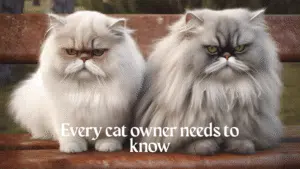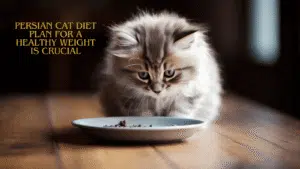That “fat Persian cat” may sound cute, but that added weight can cause a host of serious health issues if the pet is not managed properly. Pet obesity, as well as human obesity, is a growing problem, and Persian cats are no exception. Whether your cat is overweight or you are considering putting them on a diet, understanding the risks associated with being overweight is something every cat owner needs to know.
That’s why elder pet care becomes especially critical as Persian cats get older — proper weight management can help prevent complications like heart disease, diabetes and joint problems. We will discuss the common health problems of fat Persian cats and how to control their weight to ensure that they are healthy and live long lives.
What Makes a “Fat Persian Cat”?
Well, it might not be surprising to know that a “fat Persian cat” is simply a Persian cat that is indulging in some extra weight that is very detrimental for their health. Persian cats are especially susceptible to putting on weight because of their relaxed, low-energy temperaments.
They like to lounge around and rarely do much physical activity, making it easy for them to gain weight if they are overfed. But it’s crucial to tell the difference between a naturally beefy Persian cat and an overweight/obese one caused by diet or lack of exercise.
When a Persian cat becomes overweight, they open themselves up to a variety of pet health issues, including diabetes, joint problems, and heart disease. Excessive weight puts a strain on their organs, particularly their heart and joints.
It is important to identify and act on early signs of obesity in your “fat Persian cat“. Such signs may be excessive panting, lethargy, discomfort in movement, and also the additional flab around his belly.
Combating a “fat Persian cat” requires an active approach from owners. Weighing them often, giving them appropriate portions and having a schedule can help keep their obesity from becoming a serious health concern.
Arming yourself with Persian cat care tips will let you better understand the unique needs of your kitties, allowing you to avoid the long-term effects of obesity. A “Persian cat diet plan” that emphasizes portion sizes and food quality is an effective way to get your fat Persian cat back into shape..
Common Pet Health Issues in Fat Persian Cats
Obesity in Persian cats doesn’t just impact their appearance; pet health issues of various sorts come along with it. One such condition is diabetes, which develops when excess fat interferes with the body’s ability to maintain blood sugar levels.
Eventually, the added poundage causes insulin resistance, and your cat can’t control their blood sugar very well anymore. If this is not fixed, it can lead to costly and difficult treatment of long-term health complications.
Besides diabetes, “fat Persian cats” are prone to heart disease, too. Obesity leads to more work for the heart, which raises the risk of heart failure or high blood pressure. The Persian cat diet plan that limits calories and nutrient – heart– is the key to alleviate all these risks.
And if your cat is overweight, they may develop joint problems, including arthritis, because the extra weight puts stress on their joints. It must have been painful and uncomfortable, as it hinders their movement and makes daily life harder and harder to do.
Outside of these health issues, fat Persian cats frequently experience respiratory problems because excess fat around their abdomen can constrict their breathing.
Obese cats can also develop a compromised immune system, which puts them at greater risk of infections. However, with regular weight checks and proper Persian cat weight management techniques, you can avoid ever reaching that stage.
How to Create a Persian Cat Diet Plan for Weight Management
A Persian cat diet plan for a healthy weight is crucial to avoid overweight and obesity and its problems. When designing this plan, the first step is to select a complete, high-quality cat food formulated for weight management.
These recipes are lower in calories, but still contain the nutrients needed to promote good health for your feline. The higher the protein and the lower the carbohydrates you consume when combining food, the better it is, as this ensures increased muscle mass and less fat deposition.
Along with selecting appropriate foods, you need to be mindful of portioning. One of the biggest culprits for the obesity of “fat Persian cats” is overfeeding so it is important to control the amount of food you give them and not free-feed.
A healthy weight for a cat is between 20 to 40 calories per pound of body weight, per day. If your cat is already overweight, though, this number should be cut back to facilitate loss.
Diet, to some extent, is also important, but another major strategy is the addition of fiber in their diet. Fiber-rich foods make your fat Persian cat feel full, naturally curbing their overall calorie intake.
Most cats do better on multiple smaller meals a day instead of one large meal. This regulates their metabolism and prevents excessive feeding.
To senior “fat Persian cats” the diet plan should also be guided by the principles of elder pet care. An older cat might have a slower metabolism and need age-appropriate diet. Seek out low-fat but high-fiber foods, and check in with your vet to make sure you’re checking all the boxes regarding their specific dietary requirements.
Persian Cat Weight Management: Tips for Success
A “fat Persian cat” is only handled successfully with a proper balance of healthy eating, exercise, and regular care. Even though Persian cats are not considered to be very active cats, they would still benefit from exercise on a regular basis.
Give your fat Persian cat more to do by providing toys that engage their natural hunting behavior. Laser pointers, feather wands and puzzle feeders can keep them interested and help shed excess calories.
Making a certain time dedicated to playtime daily will also encourage weight regulation. Try to dedicate at least 15-20 minutes twice a day to play. You could also provide an environment that promotes activity, like climbing trees, scratching posts and raised platforms.
Such tips for the care of Persian cats can not only help prevent your cat from becoming sedentary, they can also help you keep the cat’s weight in check.
Another important pillar of Persian cat weight management is to ensure that your cat is drinking enough water. Dehydration can impede your cat’s metabolism, so it makes it harder for them to lose weight.
And while they are in your care, make sure they always have fresh water available, and perhaps add some wet food to their diet to help with hydration.
Preventing Obesity in Persian Cats
Prevention of becoming fat is the best way to tackle obesity in Persian cats. A simple Persian cat diet plan, encouraging an exercise practice and a routine feeding schedule are a few main points of preventing obesity.
Never free-feed your kitty and make sure that meals are timed and portioned correctly. In doing so, this will control and prevent overeating and regulate one’s calorie intake.
In elder pet care, older Persian cats may need a more specialized diet to avoid weight gain. Their metabolism slows down with age so it’s essential to modify their food accordingly.
Older Persian cats also need Persian cat care tips that address problems with the joints, digestive practices, and overall mobility, which can be compromised with excess weight.
Lastly, regular veterinary visits are important to monitoring your cat’s weight and general health. Speak with your vet about how best to handle your fat Persian cat’s weight.
They need to be healthy as they grow older! If you notice that your cat is starting to become overweight, don’t delay in handling it. The earlier you take steps to keep obesity at bay, the better for your cat’s long-term health.
Conclusion
Keeping your chubby Persian cat at its ideal weight can help prevent many cat related health issues. Following a balanced Persian cat diet plan, encouraging exercise, and consistently following a feeding schedule can help prevent your Persian cat from obesity along with the life threatening serious health risks it comes with.
elder pet care practices are imperative for senior bubble Persian kittens to keep healthy and active in their later years. Remember, one of the best things you can do for your fat Persian cat‘s happiness and long-term health is to keep your cat at weight.






